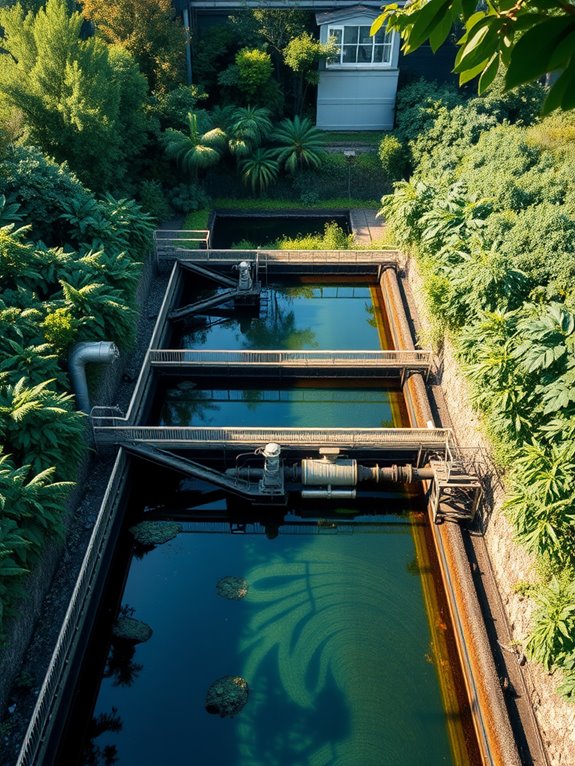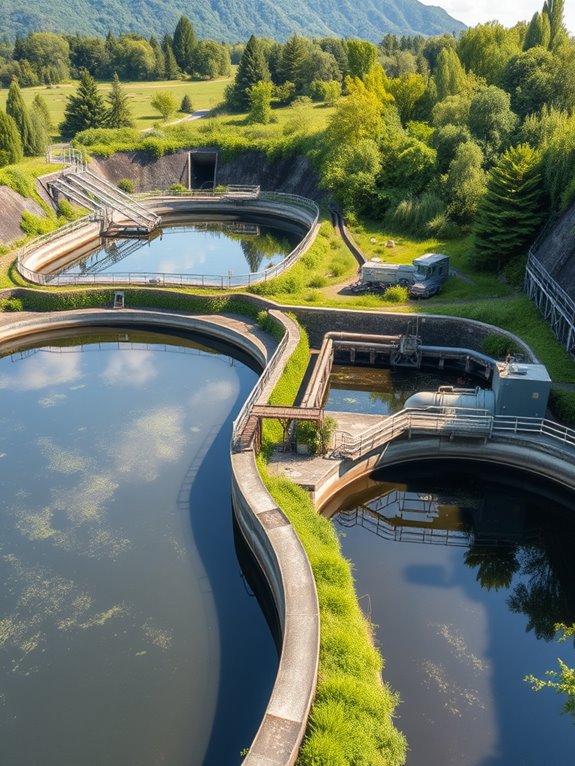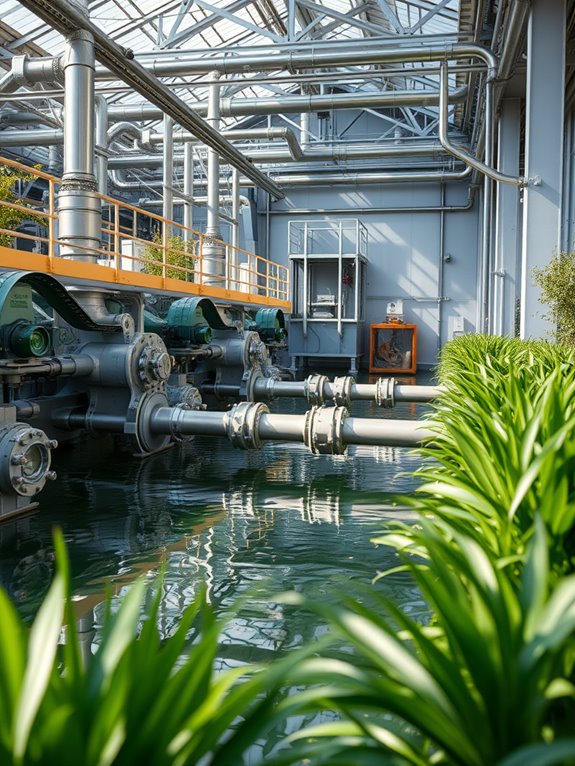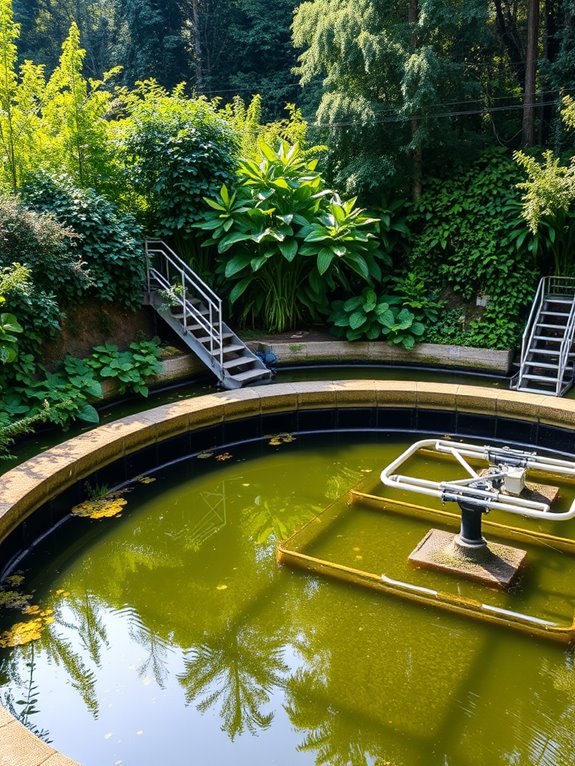Wastewater treatment plants mainly target solid waste and pathogens, but they’re often not effective at removing pharmaceuticals. While conventional methods can manage large solids and organic matter, many pharmaceuticals remain due to their stable nature. Advanced techniques like membrane filtration and oxidation processes show promise in enhancing removal efficiency. Understanding these methods and their challenges leads to better solutions. If you’re curious about the latest advancements in wastewater treatment technology and its impact on water safety, keep exploring!
The Importance of Wastewater Treatment Plants

While you mightn’t think about it often, wastewater treatment plants play an essential role in safeguarding public health and the environment. They process millions of gallons of wastewater daily, removing harmful contaminants that could otherwise pollute rivers and oceans.
By treating sewage and industrial waste, these facilities help prevent the spread of disease and protect aquatic ecosystems. You rely on them to guarantee that the water you use is safe for drinking, swimming, and other activities.
Without effective wastewater treatment, communities would face severe health risks, and our natural resources would suffer irreparable damage. Their importance can’t be overstated.
Understanding Pharmaceuticals in Water Sources
As the world increasingly relies on pharmaceuticals for health and wellness, traces of these substances have found their way into our water sources, raising concerns about their impact on ecosystems and human health.
You mightn’t realize it, but everyday activities like flushing medications or washing clothes can contribute to this contamination. Pharmaceuticals can disrupt aquatic life, leading to altered behaviors and reproductive issues in fish and other organisms.
Additionally, these chemicals may enter drinking water supplies, posing potential risks to human health. Understanding how these substances enter our water is essential for developing effective strategies to mitigate their presence.
Here’s another post you might find useful: How Does a Water Treatment Plant Work? Step-by-Step Process
How Wastewater Treatment Works

Wastewater treatment plays an essential role in addressing the contamination of water sources by pharmaceuticals and other pollutants.
When you send wastewater to a treatment plant, it undergoes several processes. First, large solids are removed through screening. Next, the water flows into sedimentation tanks, where heavier particles settle out.
Then, biological treatment occurs, using microorganisms to break down organic matter. Finally, disinfection methods, like chlorine or UV light, eliminate remaining pathogens.
Throughout this process, the treatment plant aims to reduce harmful substances, ensuring that the treated water is safe for release back into the environment or for reuse in various applications.
Here’s another post you might find useful: Are Water Treatment Plants Considered Industrial? Key Facts to Know
The Effectiveness of Conventional Treatment Methods
When you look at conventional treatment methods, you’ll see a structured process designed to remove contaminants from wastewater.
However, these methods have their limitations, especially when it comes to pharmaceuticals.
Understanding both the treatment overview and its shortcomings is essential for evaluating their effectiveness.
Treatment Process Overview
While conventional treatment methods have been the backbone of wastewater management for decades, their effectiveness in removing pharmaceuticals remains a significant concern.
Typically, these methods include physical processes like screening and sedimentation, followed by biological treatment where microorganisms break down organic matter.
You might think these processes are sufficient, but many pharmaceuticals are designed to be stable and resist degradation. As a result, what ends up in your water can still contain traces of these substances.
Understanding how these treatments work is essential for recognizing their role in protecting water quality and public health, even if they can’t eliminate all contaminants.
Limitations of Conventional Methods
Conventional treatment methods face significant challenges in effectively removing pharmaceuticals from wastewater. Many of these methods, like sedimentation and filtration, mainly target solid particles, leaving dissolved contaminants untouched.
Even advanced processes, such as activated sludge systems, struggle with certain compounds due to their chemical stability and low concentrations. You might notice that some pharmaceuticals aren’t effectively broken down, leading to potential environmental impacts.
Additionally, conventional treatments often lack the necessary technology to address emerging contaminants, which means not all harmful substances are eliminated. This highlights the need for more advanced solutions to guarantee safer water disposal.
You might also be interested in: What Is a Ballast Water Treatment System? Definition, Benefits, and Technology
Advanced Treatment Technologies

When it comes to tackling pharmaceuticals in wastewater, advanced treatment technologies are game changers.
Techniques like membrane filtration and advanced oxidation processes can markedly enhance removal efficiency.
You’ll find that these innovations offer promising solutions to the challenges posed by conventional methods.
Membrane Filtration Techniques
As you explore advanced treatment technologies, you’ll find that membrane filtration techniques stand out for their efficiency in removing pharmaceuticals and other contaminants from wastewater.
These methods use semi-permeable membranes to separate particles based on size and charge. Microfiltration, ultrafiltration, and nanofiltration are common types, each targeting specific pollutants.
The process not only reduces harmful substances but also enhances water quality for reuse or discharge. By implementing membrane filtration, you can considerably decrease the concentration of pharmaceuticals, ensuring that the treated water is safer for the environment.
This technology offers a promising solution in the fight against water pollution.
Advanced Oxidation Processes
Building on the efficiency of membrane filtration techniques, advanced oxidation processes (AOPs) emerge as cutting-edge solutions for treating wastewater contaminated with pharmaceuticals.
AOPs utilize powerful oxidants and ultraviolet light to break down complex pharmaceutical compounds into less harmful substances. You’ll find that these processes effectively degrade contaminants that traditional methods might miss.
By generating hydroxyl radicals, AOPs enhance the overall efficiency of treatment, ensuring safer water returns to the environment.
As regulations tighten on pharmaceutical waste, incorporating AOPs into treatment plants can greatly improve their performance and protect public health, making them an essential part of modern wastewater management strategies.
Factors Influencing Pharmaceutical Removal
Although many factors influence the removal of pharmaceuticals from wastewater, the efficiency of treatment processes often hinges on the specific characteristics of both the contaminants and the treatment methods employed.
For instance, the chemical structure of a pharmaceutical impacts its biodegradability and susceptibility to various treatments. Additionally, factors like temperature, pH, and retention time can greatly affect removal rates.
The concentration of the pharmaceuticals also plays a role; higher concentrations may overwhelm treatment systems.
Finally, the presence of other substances in the wastewater can either enhance or inhibit the removal process, making the treatment methods’ adaptability essential for effective outcomes.
Case Studies: Success and Challenges

While examining case studies on wastewater treatment plants, you’ll find both successes and challenges in the removal of pharmaceuticals.
Some facilities have implemented advanced technologies, like membrane filtration and activated carbon, achieving significant reductions in contaminants.
However, others struggle with specific compounds, especially those resistant to standard treatments. For instance, a plant in California reported over 90% removal of certain antibiotics but faced issues with hormone disruptors.
These insights highlight that while progress is evident, the complexity of pharmaceuticals requires ongoing adaptation and innovation in treatment processes to guarantee effective removal and protect water quality.
Future Directions for Wastewater Treatment and Pharmaceuticals
As the demand for cleaner water intensifies, wastewater treatment plants are increasingly focusing on innovative approaches to tackle pharmaceutical contaminants.
You’ll see advancements in technologies like membrane bioreactors and advanced oxidation processes, which enhance removal efficiency.
Plants are also exploring decentralized systems, allowing for localized treatment solutions.
By integrating real-time monitoring and data analytics, you can expect improved decision-making and quicker responses to contamination events.
Collaboration among researchers, regulators, and the pharmaceutical industry is essential for developing sustainable practices.
Ultimately, these efforts aim to guarantee water safety and protect public health while minimizing environmental impacts of pharmaceuticals.
Conclusion
In the grand tapestry of our ecosystem, wastewater treatment plants act as skilled weavers, attempting to remove the tangled threads of pharmaceuticals interwoven into our water sources. While conventional methods often leave loose ends, advanced technologies promise a tighter weave, capturing more of these stubborn strands. As we journey forward, embracing innovation, we can hope to create a clearer fabric of water, ensuring our rivers and lakes sparkle with purity, free from the shadows of contamination.

I’m Allen Kim, the chief editor of plumbinginto. I am a mid level plumber and assign to an local firm over 4 years of experience. During the working period, most of my experience is related to the house plumbing. I learned about the thing, when working with most experienced people in this sector, one must be as good as the inspector or better with knowledge of the project as well as the practical aspects of plumbing industry.